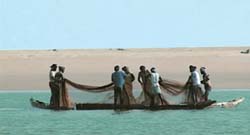We write to thank The Hindu for the timely and well-informed editorial on the future of the Olive Ridley (March 3). Sea turtles are believed to have evolved at least 200 million years ago and the Olive Ridley has found mention in the Sangam literature (400 AD). But in recent years, the increased anthropogenic pressures on the coast are threatening to wipe out these ancient creatures from our beaches and oceans. Some steps that can be taken to protect the Olive Ridley are: making the use of Turtle Excluder Devices mandatory; implementing the restriction on trawlers in fishing; and enforcing the Coastal Regulation Zone laws on buildings along the coast. V. Arun, Co-ordinator, Students' Sea turtle Conservation Network, Chennai * * * The editorial has elucidated the alarming situation the endangered species is facing. To combat this precarious scenario, the government should allocate some funds as it did in the case of tigers. The forest department should plant more eco-friendly plants such as mangroves to offset the damage caused by the indiscriminate exploitation of the eco-system. Efforts should be made to impart awareness on the issue. P. Jyothiradityan, Palakkad * * * Not only do casuarina plantations and illumination but also nets used by local fishermen, mushrooming of aqua farms, industrial effluents, poaching of eggs, and oil exploration activities in the nesting sites cause the decline of the Olive Ridley. Besides the breeding ground, the feeding ground of the Olive Ridley also faces huge pressure, thanks to the overexploitation of species such as crabs, shrimp, lobsters, sea grasses, algae, snails, fish and other small invertebrates living within 150 metres of the seashore. If the same trend persists, Olive Ridley will become extinct soon. S. Sandilyan, Mayiladuthurai * * * The editorial was something that we, the turtle researchers, have been looking forward to. I sincerely appreciate the effort of The Hindu in highlighting the issue. Sea turtles have their own ecological role and are vital for a healthy ecosystem. It is highly pathetic that the Orissa coast has turned out to be a graveyard for the Olive Ridley. A. Murugan, Tuticorin



